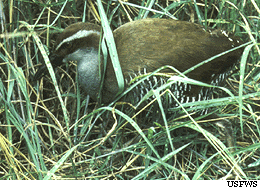- Guam Rail
Taxobox
name = Guam Rail
status = EW | status_system = IUCN3.1

image_width = 230px
regnum =Animal ia
phylum = Chordata
classis = Aves
ordo =Gruiformes
familia =Rallidae
genus = "Gallirallus "
species = "G. owstoni"
binomial = "Gallirallus owstoni"
binomial_authority = Walter Rothschild, 1895The Guam Rail, "Gallirallus owstoni", (Local name: Ko'ko' cite news |first=|last=|title=Guam native bird champion dies |url=http://www.guampdn.com/apps/pbcs.dll/article?AID=/20080606/NEWS01/806060313/1002|work=
Pacific Daily News |publisher= |date=2008-06-06 |accessdate=2008-06-08] ) is a flightless bird, endemic toGuam . The Guam Rail, which is locally known as the Ko'ko' in Chamorro, disappeared from southern Guam in the early 1970s and wasextirpate d from the entire island by the late 1980s. This species is now being bred in captivity by the Division of Aquatic and Wildlife Resources on Guam and at some mainland U.S.zoo s. Since 1995, more than 100 rails have been introduced on the island of Rota in theCommonwealth of the Northern Mariana Islands in an attempt to establish a wild breeding colony. Although at least one chick resulted from these efforts, predation (largely by feralcat s) and accidental deaths have been extremely high. A small number of birds potentially persists.Overview
Nine of the 11 species of native forest-dwelling birds have been extirpated from Guam. Five of these were endemic at the species or subspecies level and are now extinct on Guam. Two of these species, the Guam Rail and the
Micronesian Kingfisher , are being captively bred in zoos in the hope that they can eventually be released back into the wild. Several other native species exist in precariously small numbers, and their future on Guam is perilous. Most native forest species, including the Guam rail, were virtually extinct when they were listed as threatened or endangered by theU.S. Fish and Wildlife Service in 1984.A recent effort to introduce rails on Guam in a 22
hectare forested area concentrated on protecting the rails by limiting snakes using a combination of trapping and a perimeter barrier to reduce re-invasion by snakes. This endeavor allowed the tentative survival of several pairs of rails released into the area. Reproduction by the rails was reported in this control area on the basis of sounds attributed to chicks. The preliminary success constitutes one of the few bright spots in the conservation of Guam's native fauna in recent years and speaks to future opportunities to recover wildlife. [http://www.mesc.usgs.gov/resources/education/bts/impacts/birds.asp]Background
Beginning in the mid 1960s, the Brown tree snake decimated Guam's native
avifauna . The birds of Guam evolved in the absence of snake predators. They had no experience with such a predator and lacked protective behaviors against the snake. Consequently, they were easy prey for these efficient, nocturnal predators. As the snakes spread across the island, the number of snakes began to grow exponentially and bird populations plummeted.The history of this decline starts shortly after the introduction of the Brown tree snake, although appreciable losses were not evident until the 1960s. By 1963, several formerly abundant species of native birds had disappeared from the central part of the island where snakes were most populous. By the late 1960s, birds had begun to decline in the central and southern parts of the island and remained abundant only in isolated patches of forest on the northern end of the island. Snakes began affecting the birds in the north-central and extreme northern parts of the island in the 1970s and 1980s, respectively.
Zoologist Bob Beck , a GuamDepartment of Agriculture Division of Aquatic and Wildlife Resources wildlife supervisor, is credited with leading the efforts to capture the remaining wild Guam rails,Micronesian Kingfisher s and other native birds to save them from extinction. His efforts to save the Guam rail began in 1982 and lasted more than 20 years. Beck was considered to be instrumental in capturing the remaining population of Guam rails and establishingcaptive breeding programs for the species on Guam. He later established a release site and an introduced breeding population of Guam rails on the neighboring island ofRota in theNorthern Mariana Islands .Beck was also a driving force in establishing Guam rail breeding programs in
zoo s throughout the mainlandUnited States . Beck's Guam rail breeding program initially began with just three zoos in the U.S. - theBronx Zoo , thePhiladelphia Zoo and theSmithsonian National Zoological Park inWashington D.C. The program proved to be successful and was soon expanded to include other zoos. Seventeen zoos now participate in the Guam rail breeding program, as of 2008, including theAudobon Zoo inNew Orleans , theSan Diego Zoo , and zoos inChicago ,Houston andSan Antonio .The efforts by Beck, and others, to save the Guam rail have been promising. There are now approximately 120 Guam rails in
captivity in Guam and approximately 35 birds in captive breeding programs throughout the United States. Biologist Gary Wiles, who worked on the Guam rail breeding program from 1981 through 2000, said of Beck's efforts to save the Guam rail, "Bob was one of the first to begin organizing catching the birds so they could be brought into captivity, held there and bred. He started a captive population. We still have Guam rails today because of his efforts." Suzanne Medina, a wildlife biologist, also credited Beck with saving the Guam rail, "Bob Beck was the ko'ko' champion, was Guam's champion at the time for preventing the extinction of these birds."References
External links
* [http://www.birdlife.org/datazone/ebas/index.html?action=SpcHTMDetails.asp&sid=2857&m=0 BirdLife Species Factsheet]
* [http://www.mesc.usgs.gov/resources/education/bts/impacts/birds.asp USGS: Extinctions and Loss of Species from Guam: Birds]
Wikimedia Foundation. 2010.
